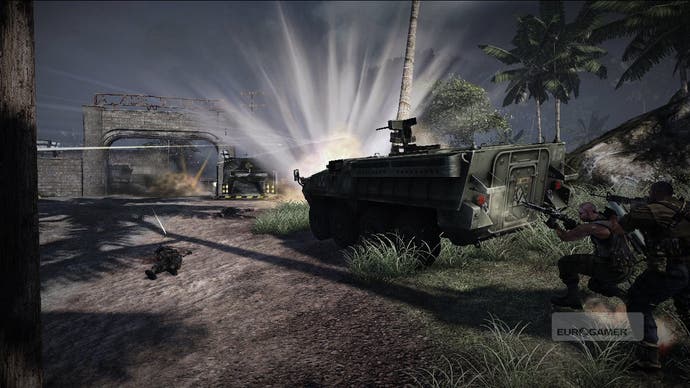MAG
Size matters.
In videogames, bigger has always equalled better. Marketing men spray ever-greater numbers at us like schoolboys competing to see who can pee furthest up a wall. 'Wonder at how many colours a Mega Drive can display!' they say. 'Marvel at how many minutes of cut-scene you can store on a PlayStation disc!' 'Quiver at the number of polygons that now comprise Lara Croft's cleavage!'
The inference is that quality always stays abreast of ambition; that the bigger, faster and more numerous the virtual things we have to play with, the happier we will be. As a result, it's numbers which fuel the fires of the console hardware cycles. And it's numbers which justify gaming's interminable sequels - explaining in neat accountant's rows why it is that we need another Gran Turismo, even when in the hands, the difference can be imperceptible.
More recently, however, there's been a move away from obsessing about figures. Nintendo's Wii and Microsoft's Natal are arguably technological sidesteps, focusing not on multiplying the underlying numbers but on changing the way we interact with them. And as gaming hardware has begun to languish, so developers have been forced to focus their ambitions elsewhere.
Why the shift? It's financial, for sure. As the boundaries of what's possible in a videogame have widened, so the costs of meeting this potential have become unaffordable. But also, there's the realisation that bigger doesn't always equal better; that, while the promise of battles featuring 256 players make for fantastic headlines and excitable playground whispers, today's players are more concerned with quality than bulk. Gamers, perhaps more than anyone, know that size matters only superficially. It's what you do with it that counts.
It's a distinction that Zipper Interactive, developer of the world's largest-scale first-person shooter, has clearly kept in mind. While most press attention has been focused on MAG's unprecedented scope, in play it fast becomes clear that the game's value is not in merely delivering a giant war-game that maintains a solid 30 frames per second, but in what the developer did next.

Not that you'll perceive the cleverness at first, however. As you enter your first 256-player battle, a tiny camouflaged cog in the fearsome machinery of war, there appears to be little rhyme or reason to the battlefield. Bodies scarper over hills, through bushes and in and out of buildings with no apparent tactical cohesion.
Dive into the throng and, to begin with, you too will act like a headless chicken, applying your default Modern Warfare lone wolf tactics to the sprawling battlefield and floundering in a wash of bullets, blood and confusion. Stand atop a hill looking down on the action and you'll observe little more than a sea of insects in a scramble for territory, one that's mostly devoid of logic or strategy.
This initial feeling is exacerbated by the fact that, played as a straight shooter, MAG is undeniably disappointing. Combat feels light and skittish in the hands, while weapons lack the kickback and weightiness of the genre's current leaders. In order to make a game of such technical ambition run smoothly and without lag, texture and detail have been reined in. The drab, muted environments, dull lighting and poor particle effects do little to make MAG's locations inviting, enjoyable places with which to familiarise oneself.


